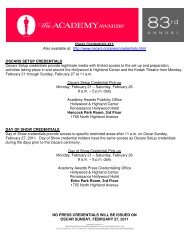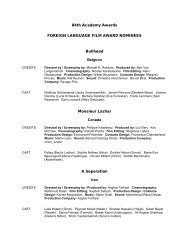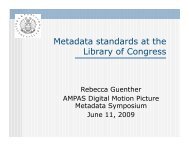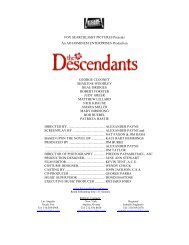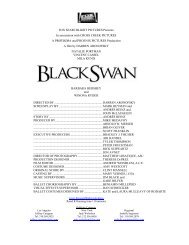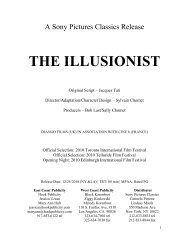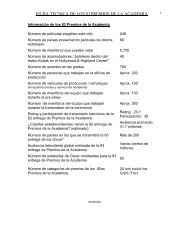Costumes & Makeup - Academy of Motion Picture Arts and Sciences
Costumes & Makeup - Academy of Motion Picture Arts and Sciences
Costumes & Makeup - Academy of Motion Picture Arts and Sciences
You also want an ePaper? Increase the reach of your titles
YUMPU automatically turns print PDFs into web optimized ePapers that Google loves.
for the rest. Although Harry Potter <strong>and</strong> his friends Ron<br />
<strong>and</strong> Hermione exist in an imaginary world, they must<br />
still be characters that the audience can relate to.<br />
When a screenplay covers several decades, or is set in<br />
a distant location, costumes help the audience know when<br />
<strong>and</strong> where each scene takes place. In the 2002 film Frida,<br />
based on the life <strong>of</strong> the Mexican artist Frida Kahlo (Salma<br />
Hayek), Frida evolves from a schoolgirl to a middle-aged<br />
woman. Costume designer Julie Weiss dressed Hayek first<br />
in a schoolgirl uniform, then as a young matron in the<br />
stylish dresses <strong>of</strong> the 1920s, then in colorful h<strong>and</strong>embroidered<br />
Mexican Indian blouses similar to what the<br />
real Kahlo wore for the rest <strong>of</strong> her life, as she becomes a<br />
confident middle-aged artist <strong>and</strong> political activist. Kahlo’s<br />
changing costumes mirror her evolution as an individual.<br />
Designers <strong>of</strong>ten adapt vintage clothing, as Arianne<br />
Phillips did in Walk the Line (2005), the story <strong>of</strong> country<br />
music star Johnny Cash <strong>and</strong> his wife, June Carter.<br />
Phillips mixed the vintage garments she found with ones<br />
she designed using vintage printed fabrics from the<br />
1950s <strong>and</strong> 1960s. She insisted on old fabric because<br />
synthetic contemporary fabrics do not move or drape<br />
in the same way.<br />
<strong>Costumes</strong> do not have to exactly duplicate the film’s<br />
period, but they need to look right to the audience.<br />
Designers may exaggerate color, style, <strong>and</strong> silhouette for<br />
dramatic effect. For example, when the director <strong>of</strong><br />
Memoirs <strong>of</strong> a Geisha felt that a sexier, more<br />
contemporary look would be more appealing to non-<br />
Japanese viewers, designer Colleen Atwood fashioned<br />
kimonos that were more shape-revealing than<br />
traditional garments.<br />
Show your students a period film (one set in the<br />
distant or recent past). Discuss how the costumes<br />
reveal when <strong>and</strong> where the film takes place. Do the<br />
period costumes affect the actor’s voice <strong>and</strong> movement?<br />
Ask students to research actual clothing from that<br />
period using history textbooks, costume history <strong>and</strong><br />
fine art books, historic portrait paintings, newspapers,<br />
<strong>and</strong> descriptions in literary <strong>and</strong> historic work. Compare<br />
actual historic costumes to the costumes in the film.<br />
How accurate were the costumes in the film? Did it<br />
matter if the costumes were not perfect reproductions?<br />
I n<br />
SUPPLEMENTAL ACTIVITY<br />
Have each <strong>of</strong> your students describe an article <strong>of</strong><br />
clothing or an accessory that he or she is wearing.<br />
Ask each to relate how he or she obtained the<br />
item. Was it a gift or a purchase? Where did it<br />
come from? How long has he or she had it? Does<br />
it have sentimental value? Discuss with your<br />
students how this kind <strong>of</strong> analysis <strong>and</strong> research is<br />
useful for designing costumes.<br />
Wardrobe, makeup, <strong>and</strong> hair are essential ingredients that actors depend upon when creating characters for motion<br />
pictures. These portraits <strong>of</strong> Johnny Depp as Gilbert Grape in WHAT’S EATING GILBERT GRAPE (1993), as the title<br />
character in DONNIE BRASCO (1997), <strong>and</strong> as Sir James Barrie in FINDING NEVERLAND (2004) illustrate subtle<br />
changes that immediately create different expectations for the audience. WHAT’S EATING GILBERT GRAPE<br />
©Paramount <strong>Picture</strong>s, DONNIE BRASCO ©Sony Entertainment, <strong>and</strong> FINDING NEVERLAND ©Miramax Films,All<br />
Rights Reserved.<br />
Activity Two:<br />
COSTUMES –<br />
CREATING<br />
CHARACTERS<br />
real life, people don’t always wear an outfit in which<br />
everything is br<strong>and</strong> new. A teenage girl might wear a<br />
favorite well-worn skirt, a pair <strong>of</strong> earrings from the local<br />
mall, <strong>and</strong> a birthday scarf from her best friend. Although<br />
the audience meets film characters when the movie<br />
starts, like real people the characters must seem to<br />
have lived before the story begins.<br />
Before shooting starts, hidden motivations in a<br />
character’s personality—anxiety, depression, money<br />
troubles, a drinking problem—<strong>and</strong> the character arc (the<br />
emotional <strong>and</strong> psychological transition the character<br />
makes through the film) are analyzed by the director,<br />
costume designer, makeup artist, <strong>and</strong> actor to determine<br />
the most effective way to tell the story. <strong>Costumes</strong>



